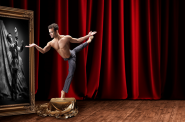One company, three styles
Darrell Grand Moultrie's warm tribute to Sammy Davis Jr brings tap to the ballet for the first time; Amy Seiwert debuts, Tim O'Donnell gives us plenty to think about.
The Milwaukee Ballet went for uplift, dirty dancing and sweet fun in its annual spring mixed-rep show Friday evening. Amy Seiwert’s Mozart Requiem, Timothy O’Donnell’s Children of the Wall and Darrell Grand Moultrie’s Simply Sammy had nothing in common, except that they all showed how deep, game, versatile and athletic the company’s dancers are.
Seiwert tagged her four lead dancers as Soprano (Luz San Miguel), Alto (Susan Gartell), Tenor (Isaac Sharratt) and Bass (Timothy O’Donnell), set off against a “chorus/orchestra” of five additional women and four men. The leads did, indeed, dance when their counterparts sang in the recorded music. Beyond that, they danced along specifically with Mozart’s notes. This rather academic approach yielded some beautiful dancing early, especially San Miguel’s lyric solo. The dancer poured it out like the loveliest cursive handwriting. She captured in her extending body and opening arms the subtlest changes in musical dynamics.
But Seiwert never strayed from this direct interpretation of the music, a practice that those in the business call “mickey-mousing.” When Mozart picked up the pace and added counterpoint, Seiwert kept on trying but couldn’t make convincing visual sense of it. We could see in the dance the moving parts we heard in the music, but the visualization of music wasn’t enough to sustain interest. The effort to simply keep up with Mozart made it impossible for Seiwert to account for the expressive subtleties she had infused into the lyric solo for her “soprano.”
As the Requiem wore on, the dance came to look more and more a puppet of the music rather than an equal partner. The sameness of the relationship between the dance and the music grew tedious. Good dances go their own way and return to the music; duller ones let the music push them around.
The women wore pointes and flowing, diaphanous gowns, by Christine Darch. The clothes took them halfway to angelhood, especially in the half-way to heaven half-light in David Grill’s lighting design. The men were bare-chested over tights. Everyone maintained the air of dignity befitting the music and the topic, and the general dance vocabulary pointed toward classical values and weightless uplift.
O’Donnell’s piece is as self-consciously decadent as Seiwert’s is self-consciously reverent. Costume designer Francessca O’Donnell put the Children of the Wall (six men, six women) in skimpy black leather-look outfits with a whiff of fetish about them. The curtain rises to Justin Genna seated on a chair, smoking. He must have been at it for a while; stark lighting cuts through a heavy dose of stage fog.
An introductory reading projected on the back scrim recounts the history of the Berlin Wall. A famous and really pretty hilarious picture of Soviet premiere Leonid Brezhnev kissing East German communist leader Eric Honecker full on the lips came into view and pretty much stayed in view for the rest of the piece.
The problem with this dance is that once you connect an artwork to a specific historical event in a specific way, that work should say something about that event beyond the projections on the back wall. Nothing in the dance addressed the stated topic, beyond the possible assumption that people who are walled in might turn to getting sweaty and desperate in loud underground dives.
Children of the Wall doesn’t really add anything to the historical discussion of the Cold War. I think this would be a better piece without the distractions of the Berlin Wall, the kinky costumes, telegraphed angst and long-dead kissing comrades. The dancing is the interesting thing — the amazing thing — here. The rest is just in the way.
The wit, verve and sweet nostalgia of Darrell Grand Moultrie’s Simply Sammy proved the perfect antidote to the Cold War hangover.
Moultrie set nine Sammy Davis, Jr., songs on a dozen Milwaukee Ballet dancers and guest Marshall Davis, Jr., a brilliant tap dancer. Rebecca Baygents Turk’s costumes — a range of glittery dresses for the women and rat-pack tuxes (you gotta loosen that bow tie) for the men — added a lot to the happy show-biz atmosphere.
Sammy Davis was all over television when I was a kid, but I’d quite forgotten just how creative a singer he was. You would never mistake him for someone else in such standards as “Anyplace I Hang My Hat Is Home,” “Bye Bye Blackbird,” “Lady Is a Tramp,” “Love Me or Leave” or “Birth of the Blues,” which Moultrie employes here. Davis even made the annoying “Candy Man” tasty.
Davis found ways to make the squarest tunes swing, and the company’s dancers let his breezy rhythms fill their sails. Free and easy hips gave them that swing and led to buoyant rushes of kinetic energy released without apparent effort. Almost everyone smiled throughout, and it didn’t look fake. Those were the smiles of physical exhilaration, of joy taken in finely tuned bodies well used.
Moultrie gave almost everyone a star turn, and no one wasted it. But my favorite bit involved Alexandre Ferreira, Erik Johnson, Ryan Martin, Marc Petrocci and Isaac Sharratt in a fireworks display of manly aerial tricks.
Marshall Davis refreshed the scene by gathering in the focus, from stage-wide exuberance to the small circle in which he laid down the iron. Davis danced mostly in place, so intensely that he drew you in first to the sophisticated rhythm and virtuosic speed and control of his tap work and second to his demeanor. This Davis, in this show, anyway, favored the slightly hunched-forward stance that Sammy practiced, but with the lightly-held ease of Fred Astaire. You look at Marshall Davis and see a man perfectly at home in his own skin, and that is a beautiful thing.
This program, given at Marcus Center Uihlein Hall, will be repeated, with some cast rotations, at 7:30 p.m. Friday and Saturday and 1:30 p.m. Sunday, April 12-14. Tickets are $30.75-99.25 at the Milwaukee Ballet ticket line, 414 902-2103, at the Milwaukee Ballet website and at the Marcus Center box office, 414 273-7206.
Dance
-
Milwaukee Ballet Brings Back Orchestra
 Jul 14th, 2025 by Bruce Murphy
Jul 14th, 2025 by Bruce Murphy
-
New Riverwest Company, Production Impresses
 Feb 10th, 2020 by Brendan Fox
Feb 10th, 2020 by Brendan Fox
-
Milwaukee Ballet Show Remakes History
 Feb 10th, 2020 by Catherine Jozwik
Feb 10th, 2020 by Catherine Jozwik























